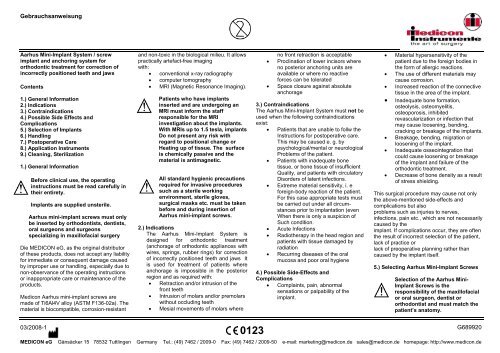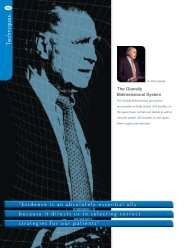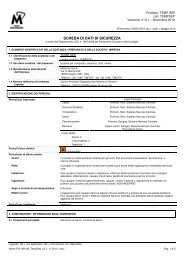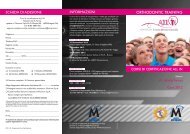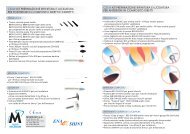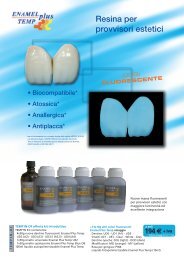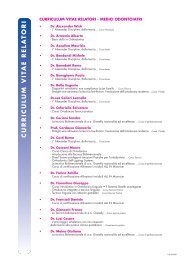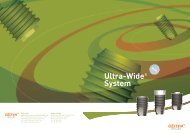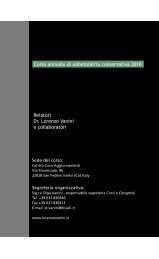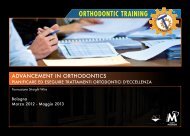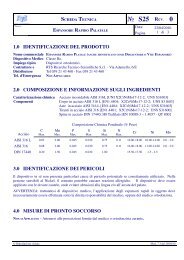Mini Implant Technical Information - American Orthodontics
Mini Implant Technical Information - American Orthodontics
Mini Implant Technical Information - American Orthodontics
You also want an ePaper? Increase the reach of your titles
YUMPU automatically turns print PDFs into web optimized ePapers that Google loves.
Gebrauchsanweisung<br />
Aarhus <strong>Mini</strong>-<strong>Implant</strong> System / screw<br />
implant and anchoring system for<br />
orthodontic treatment for correction of<br />
incorrectly positioned teeth and jaws<br />
Contents<br />
1.) General <strong>Information</strong><br />
2.) Indications<br />
3.) Contraindications<br />
4.) Possible Side Effects and<br />
Complications<br />
5.) Selection of <strong>Implant</strong>s<br />
6.) Handling<br />
7.) Postoperative Care<br />
8.) Application Instruments<br />
9.) Cleaning, Sterilization<br />
1.) General <strong>Information</strong><br />
Before clinical use, the operating<br />
instructions must be read carefully in<br />
their entirety.<br />
<strong>Implant</strong>s are supplied unsterile.<br />
Aarhus mini-implant screws must only<br />
be inserted by orthodontists, dentists,<br />
oral surgeons and surgeons<br />
specializing in maxillofacial surgery<br />
Die MEDICON eG, as the original distributor<br />
of these products, does not accept any liability<br />
for immediate or consequent damage caused<br />
by improper use or handling, especially due to<br />
non-observance of the operating instructions<br />
or inapppropriate care or maintenance of the<br />
products.<br />
Medicon Aarhus mini-implant screws are<br />
made of Ti6Al4V alloy (ASTM F136-02a). The<br />
material is biocompatible, corrosion-resistant<br />
and non-toxic in the biological milieu. It allows<br />
practically artefact-free imaging<br />
with:<br />
• conventional x-ray radiography<br />
• computer tomography<br />
• MRI (Magnetic Resonance Imaging).<br />
Patients who have implants<br />
inserted and are undergoing an<br />
MRI must inform the staff<br />
responsible for the MRI<br />
investigation about the implants.<br />
With MRIs up to 1.5 tesla, implants<br />
Do not present any risk with<br />
regard to positional change or<br />
Heating up of tissue. The surface<br />
is chemically passive and the<br />
material is antimagnetic.<br />
All standard hygienic precautions<br />
required for invasive procedures<br />
such as a sterile working<br />
environment, sterile gloves,<br />
surgical masks etc. must be taken<br />
before and during insertion of<br />
Aarhus mini-implant screws.<br />
2.) Indications<br />
The Aarhus <strong>Mini</strong>-<strong>Implant</strong> System is<br />
designed for orthodontic treatment<br />
(anchorage of orthodontic appliances with<br />
wires, springs, rubber rings) for correction<br />
of incorrectly positioned teeth and jaws It<br />
is used for treatment of patients where<br />
anchorage is impossible in the posterior<br />
region and as required with:<br />
• Retraction and/or intrusion of the<br />
front teeth<br />
• Intrusion of molars and/or premolars<br />
without occluding teeth<br />
• Mesial movements of molars where<br />
no front retraction is acceptable<br />
• Proclination of lower incisors where<br />
no posterior anchoring units are<br />
available or where no reactive<br />
forces can be tolerated<br />
• Space closure against absolute<br />
anchorage<br />
3.) Contraindications<br />
The Aarhus <strong>Mini</strong>-<strong>Implant</strong> System must not be<br />
used when the following contraindications<br />
exist:<br />
• Patients that are unable to follw the<br />
Instructions for postoperative care.<br />
This may be caused e. g. by<br />
psychological/mental or neurological<br />
Problems of the patient.<br />
• Patients with inadequate bone<br />
tissue, or bone tissue of insufficient<br />
Quality, and patients with circulatory<br />
Disorders of latent infections.<br />
• Extreme material sensitivity, i. e<br />
foreign-body reaction of the patient.<br />
For this case appropriate tests must<br />
be carried out under all circumstances<br />
prior to implantation (even<br />
When there is only a suspicion of<br />
Such condition.<br />
• Acute Infections<br />
• Radiotherapy in the head region and<br />
patients with tissue damaged by<br />
radiation<br />
• Recurring diseases of the oral<br />
mucosa and poor oral hygiene<br />
4.) Possible Side-Effects and<br />
Complications<br />
• Complaints, pain, abnormal<br />
sensations or palpability of the<br />
implant.<br />
• Material hypersensitivity of the<br />
patient due to the foreign bodies in<br />
the form of allergic reactions.<br />
• The use of different materials may<br />
cause corrosion.<br />
• Increased reaction of the connective<br />
tissue in the area of the implant.<br />
• Inadequate bone formation,<br />
osteolysis, osteomyelitis,<br />
osteoporosis, inhibited<br />
revascularization or infection that<br />
may cause loosening, bending,<br />
cracking or breakage of the implants.<br />
• Breakage, bending, migration or<br />
loosening of the implant.<br />
• Inadequate osseointegration that<br />
could cause loosening or breakage<br />
of the implant and failure of the<br />
orthodontic treatment.<br />
• Decrease of bone density as a result<br />
of stress shielding.<br />
This surgical procedure may cause not only<br />
the above-mentioned side-effects and<br />
complications but also<br />
problems such as injuries to nerves,<br />
infections, pain etc., which are not necessarily<br />
caused by the<br />
implant. If complications occur, they are often<br />
the result of incorrect selection of the patient,<br />
lack of practice or<br />
lack of preoperative planning rather than<br />
caused by the implant itself.<br />
5.) Selecting Aarhus <strong>Mini</strong>-<strong>Implant</strong> Screws<br />
Selection of the Aarhus <strong>Mini</strong>-<br />
<strong>Implant</strong> Screws is the<br />
responsibility of the maxillofacial<br />
or oral surgeon, dentist or<br />
orthodontist and must match the<br />
patient’s anatomy.<br />
03/2008-1<br />
0123<br />
G689920<br />
MEDICON eG Gänsäcker 15 78532 Tuttlingen Germany Tel.: (49) 7462 / 2009-0 Fax: (49) 7462 / 2009-50 e-mail: marketing@medicon.de sales@medicon.de homepage: http://www.medicon.de
Gebrauchsanweisung<br />
Before using the Aarhus <strong>Mini</strong>-<strong>Implant</strong> Screws,<br />
the maxillofacial or oral surgeon, dentist or<br />
orthodontist must explain the desired course<br />
of treatment and the expected result in detail<br />
to the patient.<br />
Selecting the incorrect implants may result in<br />
premature implant loss along with loosening,<br />
bending or breakage of the implant. Damage<br />
and scratches will reduce the strength of the<br />
product and cause premature fatigue of the<br />
implant. This will adversely affect the success<br />
of the treatment.<br />
6.) Handling<br />
Aarhus <strong>Mini</strong>-<strong>Implant</strong> Screws can be inserted<br />
in the maxilla in a vestibular of palatal position<br />
or in the alveolar ridge.<br />
Insertion in the mandible should be vestibular<br />
only. Based on current knowledge, we advise<br />
against lingual insertion and insertion in the<br />
vicinity of extraction wounds, dental follicles<br />
and first teeth.<br />
The following positions offer the best<br />
conditions for an insertion of the screw:<br />
Maxilla:<br />
• The infrazygomatica crest<br />
• The anterior nasal spine<br />
• The palate<br />
Mandibula:<br />
• The retromolar area<br />
• The symphysis<br />
• The alveolar process<br />
Aarhus <strong>Mini</strong>-<strong>Implant</strong> Screws have a selftapping<br />
thread, which makes pilot drilling<br />
unnecessary. However, it is up to the surgeon<br />
to decide whether it is better to drill a pilot<br />
hole into the cortical bone of the lower jaw. In<br />
this case select the drill and length to match<br />
the screw diameter. Drill a cavity of at least<br />
4.0 mm with adequate cooling and at a speed<br />
of 800 – 1500 rpm.<br />
The screw must be inserted in bone of<br />
appropriate quality only.<br />
It is important to ensure that the screws are<br />
loaded with an appropriate orthodontic<br />
loading system immediately after insertion. If<br />
immediate therapeutic loading is not possible,<br />
an unloaded healing phase of at least three to<br />
four weeks is required.<br />
To ensure a safe function of the Aarhus <strong>Mini</strong>implant<br />
Screw, it must be securely anchored<br />
in the bone (primary stability) and the screw<br />
head must be placed in the region of the<br />
alveolar gingiva. When using the Aarhus <strong>Mini</strong>-<br />
<strong>Implant</strong> Screw as an anchoring element,<br />
make sure that the head and the surrounding<br />
soft tissue are not subject to any unfavourable<br />
mechanical stresses (such as movement of<br />
the mucosa, influence by bands and/or<br />
tongue, manipulations).<br />
Use only 50cN springs for<br />
anchorage, connected directly to<br />
the screw or to the teeth that are<br />
anchored by the screws.<br />
The line of force must always pass through<br />
the screw if the screw is used as direct<br />
anchorage. Forces that induce torque around<br />
the longitudinal axis of the screw (identical to<br />
the force that is required to insert or remove<br />
the screw) must be avoided. A thorough force<br />
system must be developed before insertion of<br />
the screw.<br />
Other important information is covered in the<br />
various manuals on surgical technique.<br />
Aarhus <strong>Mini</strong>-<strong>Implant</strong> Screws are<br />
designed for single use only. An<br />
explanted Aarhus <strong>Mini</strong>-<strong>Implant</strong><br />
Screw or one that has been<br />
otherwise used must not be reinserted.<br />
Even if the screw appears undamaged, there<br />
may be minor defects and invisible<br />
overloading which could result in early wear<br />
and risk to the patient.<br />
The packaging label carries a Lot no. We<br />
recommend transferring this Lot no. to the<br />
patient records as this number allows tracing<br />
the production history of the implant back to<br />
the raw material.<br />
The implants and instruments are adapted<br />
to each other. Any useof implants and<br />
instruments from other manufactures in<br />
combination with Medicon products entails<br />
unpredictable risks, since the products are<br />
not adapted to each other. To avoid risks,<br />
only such Medicon products that are<br />
designated for combination with each other<br />
may be combined with each other.<br />
7.) Postoperative Care<br />
Periodic postoperative care and observation<br />
and also reduced physical activity after the<br />
operation and during the healing phase is<br />
very important for the success of the<br />
treatment. <strong>Implant</strong>s may come loose, be<br />
displaced, bend or break as a result of<br />
overload. The supervising physician is<br />
responsible for deciding the type, duration<br />
and intensity of physical activity after the<br />
operation.<br />
The patient must be advised that ignoring<br />
medical advice regarding the above and other<br />
areas may result in unforeseeable<br />
complications. This is particularly applicable if<br />
the patient manipulates the implant or<br />
appliance himself. Patients who are exposed<br />
to magnetic fields and/or electrical influences<br />
must be informed of the required precautions.<br />
Patients must inform medical personnel of the<br />
implant before any medical examinations.<br />
The patient must be instructed to inform, with<br />
delay, the operating surgeon of unusual<br />
changes at the operating site. The patient<br />
must be monitored carefully if there is a<br />
manifest change in the fixation region. The<br />
surgeon must consider possible consequences,<br />
e.g. implant failure, and discuss<br />
with the patient any necessary measures<br />
for further healing.<br />
It cannot be excluded that implants will<br />
break, loosen, corrode, migrate through<br />
tissue and cause pain.<br />
The implants must be removed after the<br />
treatment has been completed. We can<br />
therefore only accept liability for implants up<br />
to the completion of treatment.. We do not<br />
accept any responsibility for any damage<br />
arising from implants which remain in the<br />
body after conclusion of treatment.<br />
8.) Application Instruments<br />
When inserting implants, use only those<br />
instruments specifically designed and sold for<br />
the Aarhus <strong>Mini</strong>-<strong>Implant</strong> System (see the<br />
product brochure).<br />
The instruments intended for use of the<br />
system are subject to wear and<br />
mechanical stress even during normal use,<br />
and particularly if excessive force is used. In<br />
order to prevent failure or mechanical damage<br />
of the application instruments during surgery,<br />
they must always be checked before each<br />
use for mechanical integrity, full functional<br />
range, and possible deformation. Instruments<br />
with any damage must be discarded.<br />
03/2008-1<br />
0123<br />
G689920<br />
MEDICON eG Gänsäcker 15 78532 Tuttlingen Germany Tel.: (49) 7462 / 2009-0 Fax: (49) 7462 / 2009-50 e-mail: marketing@medicon.de sales@medicon.de homepage: http://www.medicon.de
Gebrauchsanweisung<br />
9.) Cleaning, Sterilization<br />
It is the responsibility of the user to make<br />
sure that appropriate cleaning and disinfecting<br />
methods are used.<br />
Trained personnel must carry out cleaning<br />
along with maintenance and inspection for<br />
damage prior to the initial sterilization of<br />
new products.<br />
The products must be cleaned, disinfected<br />
and sterilized prior to each use.<br />
Preparation for decontamination<br />
The screw implants are supplied in colourcoded<br />
screw holders (white, blue, red) and<br />
with a transparent cover and base for<br />
protection during transport and storage. The<br />
cover and base must be removed and the<br />
implants in the screw holder inserted into the<br />
implant cassette designed for the system, and<br />
the cassette lid must be closed. Remove any<br />
surface soiling resulting from use on the<br />
surfaces of the implant cassette with a<br />
disposable cloth or paper towel.<br />
We recommend automated cleaning .<br />
Cleaning<br />
Suitable alkaline cleaners or those with a<br />
neutral pH can be used. The cleaning agent is<br />
selected depending on<br />
the properties of the materials of the Aarhus<br />
<strong>Mini</strong>-<strong>Implant</strong> System and national directives<br />
and recommendations.<br />
The cleaning and disinfection device<br />
(RDG) must comply with DIN EN ISO<br />
15883-1.<br />
1. Precleaning 1: 1 minute with<br />
demineralized cold water with no<br />
additives;<br />
2. Draining;<br />
3. Precleaning 2: 3 minutes with<br />
demineralized cold water with no<br />
additives;<br />
4. Draining;<br />
5. Cleaning: with demineralised water,<br />
heat to 55°C and wash/clean for 5<br />
minutes, add cleaning agent at 45°C,<br />
alkaline cleaning agents, dosage<br />
0.5%;<br />
6. Draining;<br />
7. Neutralisation: 3 minutes with hot<br />
water (>40°C) with neutraliser<br />
added, dosage 1 ml/l;<br />
8. Draining<br />
9. Final rinse: 2 minutes with hot tap<br />
water (> 40°C) (no other additives)<br />
10. Draining<br />
The parameter provided by the manufactures<br />
of cleaning agent with regard to concentration,<br />
temperature and exposure time<br />
must be adhered to. Automatic dosage<br />
devices must be controllable.<br />
Thermal Disinfection<br />
When using demineralized water, thermal<br />
disinfection should be carried out at<br />
temperatures from 80-95°C, with a<br />
corresponding soaking time according to the<br />
A0 approach (DIN EN ISO 15883-1).<br />
Drying<br />
Esure that the cleaning/disinfection device is<br />
programmed for an adequate drying time<br />
Maintenance, Inspection, and Testing<br />
Following cleaning and disinfection, the<br />
Aarhus <strong>Mini</strong>-<strong>Implant</strong> Screws and implant<br />
cassettes must be macroscopically clean, i.e.<br />
free of visible residue. This is checked by<br />
visual inspection. Critical areas require<br />
particularly careful checking. Any parts<br />
cleaned insufficiently must be cleaned again<br />
and must then be rinsed thoroughly.<br />
Sterilization<br />
Only cleaned and disinfected Aarhus <strong>Mini</strong>-<br />
<strong>Implant</strong> Screws may be sterilised. For<br />
sterilization, use the following sterilization<br />
procedure subject to national regulations:<br />
• Triple fractionated vacuum method<br />
with sufficient product drying<br />
• Autoclave in accordance with DIN<br />
EN 13060 or DIN EN 285 and<br />
validated in accordance with DIN EN<br />
17665-1.<br />
Sterilization time and temperature: At<br />
least 5 minutes holding time at 134°C<br />
Packaging<br />
The instruments must be packed in a suitable<br />
sterile barrier system. The sterile barrier<br />
system must comply with the following<br />
criteria:<br />
• DIN EN 868 and DIN EN ISO 11607<br />
• suitable for autoclaving (steampermeable)<br />
• adequate temperature resistance up<br />
to 138°C<br />
Sterilization accessories and sterilizing<br />
packaging must conform to the package<br />
contents and the sterilization method.<br />
Storage<br />
To prevent condensation from forming,<br />
major temperature fluctuations should be<br />
avoided. Chemicals must not be stored<br />
with the Aarhus <strong>Mini</strong>-<strong>Implant</strong> Screws.<br />
Prepared sterile instruments must be<br />
stored in a suitable reusable sterilizing<br />
container in dry, dustproof, low-germ, dark<br />
and cool spaces that are vermin-proof.<br />
The approved local storage period<br />
depends on the type of sterile barrier<br />
system and the storage conditions. The<br />
operator must specify the approved<br />
storage period.<br />
It is the users’ responsibility to validate<br />
the recommended sterilization parameters,<br />
or any other steam sterilization process<br />
than those recommended by Medicon, so<br />
that any differences regarding sterilization<br />
chambers, wrapping methods and load<br />
configurations are taken into account and<br />
the obligatory sterility assurance level<br />
(SAL) of 10 -6 can be achieved.<br />
Please contact Medicon eG if you have<br />
further questions concerning the implants<br />
or instruments.<br />
CAUTION: For USA, federal law restricts<br />
this device to purchase by or on behalf of<br />
Physican or hospital.<br />
03/2008-1<br />
0123<br />
G689920<br />
MEDICON eG Gänsäcker 15 78532 Tuttlingen Germany Tel.: (49) 7462 / 2009-0 Fax: (49) 7462 / 2009-50 e-mail: marketing@medicon.de sales@medicon.de homepage: http://www.medicon.de


